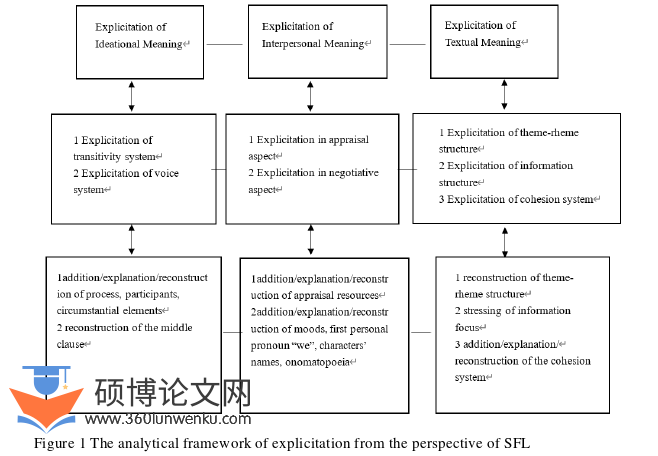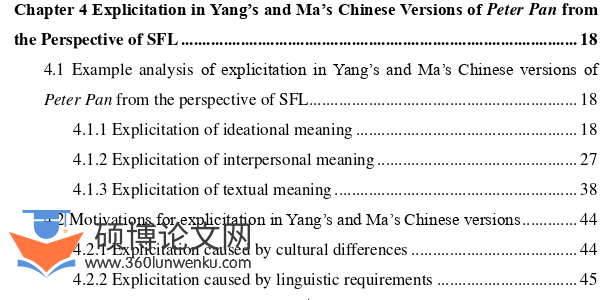本文是一篇语言学论文,本文从SFL的角度对杨致远和马云翻译《彼得·潘》时使用的外显技术进行了比较分析。经过前几章中的示例分析,以下列出了主要发现。
Chapter 1 Introduction
1.1 Background of the research
Peter Pan, wrote by Sir James Barrie, is a classical children’s literature in the world, popular among readers for a century around the world at large. It tells a story with wonderful imagination about friendship, love and affection, and about constant adventures. As a children’s literature, Peter Pan is also loved by adults, because it touches them by the theme of never growing up. The first Chinese translation started the adventure on the Neverland for Chinese readers in 1929 and various translators have offered their versions in different years after that, each with its distinct features.
Peter Pan has many dialogues, complicated words and long sentences as well as many imaginary creatures, exotic things, and complex relations among characters. These may cause trouble for children. Yan Weiming (1998) believes that in the translation of children’s literature, it is translators’ responsibility to make the meaning easier to understand rather than leaving the meaning for children to guess (严维明 1998: 53-55). As a translation technique, explicitation intends to make the translated versions clearer in meaning to help readers better understand the characters, plots, and themes of the source text. At the same time, SFL is believed to be a very useful tool in discourse analysis, and is widely adopted in translation studies.
..............................
1.2 Significance of the research
Among dozens of Chinese translations, the thesis chooses Yang Jingyuan’s and Ma Ainong’s. They are both very famous translators in children’s literature. Yang is famous for her Chinese translations of The Wind in the Willows and Ma for Harry Potter. Their versions of Peter Pan have gained wide attention and have great influence in China.
The thesis intends to explore explicitation made in the two Chinese versions, the effects of those phenomena and the motivations behind. Through analysis from SFL perspective, the writer hopes that people could pay more attention to the explicitation skill and its important role in translation. The thesis could serve as a supplement to the study of Peter Pan, help to deepen the understanding and appreciation of the two versions, and provide reference for its future translation and criticism practice; it could help translators to better understand and adopt explicitation skill and provide reference for the translation of children’s literature.

语言学论文参考
.............................
Chapter 2 Literature Review
2.1 Previous research on explicitation
Vinay and Darbelnet (1958: 342) first propose the terminology “explicitation”. They think that as a translation skill, it refers to the process or result that the implied information in the source language is made explicit in the translated language. Such information is supposed to be inferred from the context or situation of the source language.
In 1986, Blum-Kulka (1986: 19) firstly proposed “the explicitation hypothesis”. “The process of interpretation performed by the translator on the source text might lead to a target language text which is more redundant than the source language text. The redundancy can be expressed by a rise in the level of cohesive explicitness in the target language text.” She believes that the explicitation is an inherent feature of translation and a universal strategy of language mediation.
However, Séguinot (1988: 106) believes that explicitation is not limited at the cohesion level. She expounds three forms of explicitation: “Something is expressed in the translation which was not in the original, something which was implied or understood through presupposition in the source text is overtly expressed in the translation, or an element in the source text is given greater importance in the translation through focus, emphasis, or lexical choice.
The study of explicitation could be divided into two stages with 1993 as a turning point. Mona Baker (1993: 243) defines explicitation as “a marked rise in the level of explicitness compared to specific source texts and to original texts in general.” She views explicitation as one of the universals of translation, which are the special linguistic features of translated versions, which are produced because of the particularity of translation activity and are irrelevant to the two languages’ influence in the translation process (Mona Baker 1993: 243-245).
..............................
2.2 Previous research on SFL and its application to explicitation
2.2.1 Previous research on SFL and its applicability to Chinese
Systemic Functional Linguistics is established by Halliday. His inspiration comes mainly from the ideas of Saussure, Hjelmslev, Malinowski, Firth, and the Prague School linguists, as well as the work of American anthropological linguists and Chinese scholars (胡壮麟等 2008: 21-24).
He thinks, “A language is a complex semiotic system, having various strata.” (Halliday and Matthiessen 2004: 24) One stratum links with another through realization. The choice of semantics is realized through the choice of lexicogrammar, and the choice of lexicogrammar is realized through the choice of phonology. In this way, language is connected with what is outside language, and the level of semantics is languages’ realization of context, linking lexicogrammar with eco-social environment. To realize the same meaning, there may be several lexicogrammar choices, and vice versa. Therefore, the differences in the stratum of lexicogrammar show differences in the stratum of semantics. (胡壮麟等 2008: 15-17)
Halliday (1994) believes that language has three meta-functions, ideational function, interpersonal function and textual function. They are three parts at the semantic stratum. For these meta-functions are highly generalized and abstract, they are further divided into several semantic systems (胡壮麟等 2008: 45). There are transitivity and voice in ideational function, mood and modality in interpersonal function, and theme-rheme structure, information structure and cohesion system in textual function. Halliday’s meta-function theory starts from clauses (Halliday 1994). Hu Zhuanglin, Zhu Yongsheng and Zhang Delu first introduced SFL to China in 1989 in their book A Survey of Systemic-Functional Grammar. During these years, they have re-edited the book, keeping up with the new development of SFL.
.................................
Chapter 3 Theoretical Framework .................................... 12
3.1 Three meta-functions ....................................... 12
3.1.1 Ideational meaning ........................................ 12
3.1.2 Interpersonal meaning ................................. 13
Chapter 4 Explicitation in Yang’s and Ma’s Chinese Versions of Peter Pan from the Perspective of SFL ..................... 18
4.1 Example analysis of explicitation in Yang’s and Ma’s Chinese versions of Peter Pan from the perspective of SFL............... 18
4.1.1 Explicitation of ideational meaning ............................. 18
4.1.2 Explicitation of interpersonal meaning ............................ 27
Chapter 5 Conclusion ........................................ 48
5.1 Summary of the findings ............................... 48
5.2 Limitations and suggestions for future research ................................. 49
Chapter 4 Explicitation in Yang’s and Ma’s Chinese Versions of Peter Pan from the Perspective of SFL
4.1 Example analysis of explicitation in Yang’s and Ma’s Chinese versions of Peter Pan from the perspective of SFL
Based on the three meta-functions, explicitation of the two translators in their work of Peter Pan are compared. In terms of ideational meaning, explicitation examples are divided according to transitivity and voice. In terms of interpersonal meaning, explicitation are explored from appraisal and negotiative aspects. In terms of textual meaning, it deals with theme-rheme structure, information structure and cohesion system.
4.1.1 Explicitation of ideational meaning
As stated before, through the ideational meaning, children get to know what things happened on the Neverland at what time and what thoughts Peter and other characters’ hold. The transitivity system presents the characters’ experiences on the Neverland and in their mental world through process, participants and circumstantial elements, and through voice, children get to know the source of an action. As a novel for children, it is important to state the scenes and plot clearly, and let them know what the author tries to depict in the clauses.
4.1.1.1 Explicitation of transitivity
In terms of transitivity, the process is the most central element in the configuration of “process + participants + circumstances”. Participants are close to the center and are directly involved in the process. Circumstantial elements are peripheral in the configuration and are optional. (Halliday and Matthiessen 2004: 176) This transitivity configuration is simple, which “makes sense to very young children, who are learning their mother tongue”. (Halliday & Matthiessen, 2004: 175) Children prefer dynamic actions compared with static depiction. It requires attention to the use of process.

语言学论文怎么写
.............................
Chapter 5 Conclusion
5.1 Summary of the findings
The thesis conducts a comparative analysis of the explicitation technique applied in Yang’s and Ma’s translation of Peter Pan from the perspective SFL. After example analysis presented in the previous chapters, major findings are listed below.
Firstly, both Yang and Ma have made explicitation of the ideational meaning, interpersonal meaning and textual meaning.
In ideational meaning, they make explicitation through addition, explanation and reconstruction of the processes, participants and circumstantial elements, and change the voice of clauses. In this way, the implied meaning of the source text is explicated clearer; the plots are more coherent, and the scenes depicted are more specific. Children could easily grasp the plots, image the scenes, and get to know strange background information. Yang tends to explain the information in source text more.
In interpersonal meaning, they make explicitation by adding, explaining, and reconstructing appraisal and negotiative resources. The reconstruction method is often used in this type of explicitation. The explicitation of attitude could help children to understand the characters’ personality and events’ influence better; the explicitation of graduation could draw for them a clearer relationship network, show the characters’ mental experience more powerfully, and arouse children’s empathy with them. The explicitation of engagement, the change of mood, the use of the inclusive “we”, the reconstruction of the characters’ names and the emphasis on onomatopoeia all contribute to forge a closer relationship with children. Through these ways, children are invited to participate in the adventure and be the narrator’s companions by sharing his/her value and assessment.
reference(omitted)
